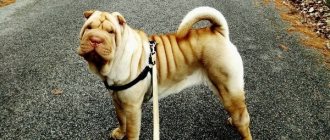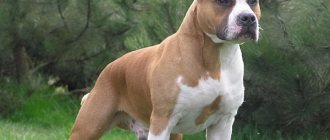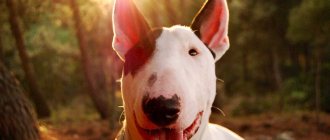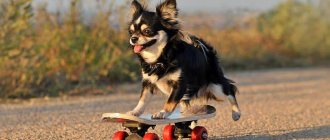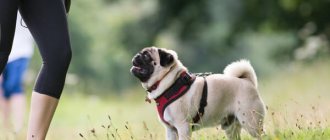The dachshund is a hunting dog breed that first appeared in the 14th century in Germany.
Over such a long period of existence, most breeds lose any skills as unnecessary.
But dachshunds have retained all the features that were originally put into them - intelligence, activity, courage, which are inherent in real hunters.
Dachshunds are also extremely independent.
Features of raising a dachshund
Rules for raising dachshunds:
- Dachshunds are stubborn dogs, so you will need to be patient before training them. It usually takes two to five days to study one command.
- Usually, training puppies requires a lot of persistence, because they behave like children: they play pranks, do not calm down, and sometimes even bite.
- When raising a pet, you need to pronounce commands loudly and clearly, without adding unnecessary words.
- When pronouncing the taxi's name, there is no need to do so in a rude, abusive tone.
- Violence and cruelty should never be used as punishment. The restless person is punished with such orders as “Place”, “No”, etc.
Features of care and conditions of detention
Dachshunds can live in small apartments, but they need their own space with a bed, water bowls and food. There should always be water in the bowl, and food only during feeding.
The coat of long-haired dachshunds needs to be looked after, combed every 2-3 days, and washed with conditioner. Short-haired dogs should be dried with a dry towel or mitten. Typically, these dogs love water, so there will be no problems with washing after walks.
When preparing a diet, it is important not to overfeed your pet - the spine may not be able to withstand a lot of weight. If you are raising a Dachshund puppy, you need to teach him not to steal food from the table. For pets who love active activities, the caloric content of food can be increased. To calculate your calorie intake, you can contact your veterinarian or professional dog trainer.
Due to the weakness of the spine, puppies should not be picked up by the scruff of the neck and adult dogs should not be handled by small children. They may accidentally drop them, which can injure the intervertebral discs.
With proper care, the weight of an ordinary representative of the breed will be in the range of 8-10 kilograms. Miniature and dwarf breeds will weigh up to 4-7 kg respectively.
How to raise and train a puppy?
To raise a child correctly, you need to understand that he is still a child. Raising and training a dachshund is an interesting activity that strengthens the relationship between owner and dog. What needs to be taught to a child and how to train it at a given age is further in the article.
At 1 month
A one-month-old puppy is just beginning to get acquainted with the world around him, he wants to play and move, he is interested in every sound he hears. Classes with dachshunds at this age are aimed at preventing the appearance of aggression and negative emotions in dogs.
At 2 months
The puppy develops a voice, he begins to bark more often and does it quite loudly. It’s time to wean a two-month-old baby from his mother’s breast and accustom him to a new place.
At 3 months
The three-month-old dachshund begins to be interested in walks outside and actively splashes out energy. And in most cases this is expressed in damage to the owner’s things. To prevent your baby from ruining literally all the things and furniture in the house, it is worth teaching him such commands as “Come”, “Ugh” and “Sit”. We must try to train more gently. Caress, praise and treat him more often. If it is clear that the little dachshund is not in the mood to exercise, there is no need to force him. You just need to reschedule the training for another day.
At 4 months
The four-month-old taxi driver is beginning to show his leadership qualities. And at this stage it is important to let the pet understand that the person is the authority in the house. There is no need to indulge the pet, because otherwise the owner risks not receiving recognition from the dog.
At 5 months
This is a more conscious age, which is characterized by an active interest in understanding the world around us, especially outside the walls of the home. At this stage, you need to walk your pet more often. He must be taught not to be afraid of other people's dogs, and also to show himself with dignity on the street.
From 6 to 8 months
During this period, females and males exhibit peculiar behavior. The boys try to establish themselves in the role of leader and leader, behaving quite aggressively and pompously. And girls go through their first heat and puberty. Strength of character is required on the part of the owner. You need to try to protect your dachshund from negativity. In addition, it is fair to stop your pet’s bad behavior.
From 9 months to 1 year
This is the last stage before the dachshund finally matures. She becomes calm and obedient. From the age of nine months, taxi drivers begin more complex training, and also reinforce previously completed training lessons.
Training by month
1 month – accustoming to a nickname. The dog must know its name. How to train a dog to respond is described above.
2 months – “You can’t”, “To me”, “Place”. Because Few breeders take walks at this age (due to lack of vaccinations), these commands are quite enough to control the puppy indoors. However, it is necessary to begin accustoming your baby to a leash and collar at this age.
3 months – “Stand”, “Sit”, “Give me your paw”, “Show your teeth”. The dog should also know that the toilet is only outside.
At 4 months, the dog must unconditionally come to the owner upon request; eat only what the owner gave; When walking, the dog should calmly walk next to the person, without tugging on the leash.
At 5-6 months, the puppy begins a “transitional age”, when he begins to test the boundaries of what is permitted and often does not follow commands. During this period, the owner needs to gather all his patience and continue training in the same mode as before. In no case should you resort to physical punishment for disobedience, because This will forever undermine the puppy's trust in the person.
What should you teach your puppy?
Accustoming to a nickname
The first thing you need to start raising a dachshund in a city apartment is to accustom the dog to its own name. During training, the dog's name is pronounced before giving commands. This allows you to attract her attention and helps your four-legged friend get his bearings.
The dachshund is able to quickly remember its name. To learn, you will need to perform a few simple steps:
- You need to stand away from your pet and, holding a treat in your hand, begin to gently call him to you by name.
- If the first step of training worked, you need to praise and treat the baby.
- The next stage of training is a little more difficult: you need to go to another room and from there start calling the dachshund to you.
You need to call your pet in a calm tone and quietly. If he doesn't respond, you need to try repeating his name more firmly and persistently.
Getting used to a leash and collar
Training to a collar begins when the taxi dog is already two months old. You need to put a collar on your baby. He will inevitably begin to resist and try to remove it, but you need to be patient and not give in to emotions. A little later, the baby dachshund will get used to such equipment and will stop noticing it. You need to choose the right collar:
- you need to take a soft and textile product that will not rub or squeeze the baby’s neck;
- The carabiner should hold the collar firmly, but do not let it be too heavy.
Dog trainers recommend buying a harness. This is due to the structure of the dachshund's body: its bones are vulnerable, especially during puppyhood. The harness helps to evenly distribute the load on the skeleton and does not put pressure on certain areas.
Toilet training at home and outdoors
Up to three months, puppies go to the toilet at home, that is, in a tray or on a diaper. Each puppy will get used to a new way of walking when needed differently: one will do it in a few months, another only after a year.
To toilet train your baby, you need to monitor him and respond in time to his desire to relieve himself. You have to take it to the right place every time. If the puppy has done “business” on the floor, you need to wipe up the puddle and put a piece of dirty rag in the tray.
There is no need to scold the dachshund if he “missed the mark” a little and partially stained the floor. And especially not to poke your pet’s nose into what has been done. On the contrary, you need to praise and treat him.
When the taxi driver gets used to the litter box and starts using it on his own, it’s time to start training for the outdoor toilet. It is much easier to train a puppy than an adult representative of the breed. If it is clear that the baby is going to relieve himself at home, you need to say “Ugh” and immediately go outside with him. When the baby does “things,” you need to praise and treat him.
Training a dog to be left alone?
The care of the owner is a great stress for any pet, including the dachshund. After all, these four-legged animals are so strongly attached to their person that by the age of six months they can no longer imagine their life without the presence of their owner. And if the taxi driver is often left alone, then upon returning you will probably find unpleasant “surprises”: damaged and chewed things, a mess in the house. Therefore, it is necessary to teach your pet to easily cope with loneliness and separation.
And here are a few rules and training recommendations that will help the owner teach the dog order:
- There is no need to express a lot of emotions before leaving. A pet associates a long goodbye with being abandoned. But you can’t leave unnoticed either;
- when the owner returns home, there is no need to hug the pet as if you haven’t seen it all your life. You need to calmly pet the baby and continue personal affairs;
- The dog must know that the owner will return. You need to try to “play” leaving home. For three or four days in a row you have to pretend that you are getting ready, get dressed and leave the apartment. Wave to your pet and walk out the door. And literally in one or two minutes they will return again. This way the dachshund will understand that a departed owner always returns;
- you need to wean the four-legged animal from reacting to the fact that the owner is leaving. Get dressed, say goodbye to your pet, and still not go anywhere.
Dachshund Training Basics
Training and education of dachshunds should begin as early as possible, almost from the moment they are born. Dachshunds are much smarter than their relatives, and if you delay training, you can waste valuable time.
First of all, it is necessary to build the dog’s training based on its unconditioned reflexes. When the puppy is one month old, you can proceed directly to the development of conditioned reflexes of the animal.
There are several rules that will help the owner find the answer to the question of how to raise a dachshund:
- The command must be spoken before the owner shows what needs to be done. For example, with the command “Sit!” you must first say and then press your hand on the dog.
- The unconditioned reflex must follow the execution of the conditioned reflex. For example, it is not allowed to distract the animal from carrying out a command and treat it with a treat, or not wait for the command to be completed. The dog will understand that he is receiving praise for nothing, and will not listen in the future. Or she will begin to follow the command after she has been treated.
- It is important that the dog is not distracted by anything during the first stages of training. All her attention should be concentrated on following the owner’s instructions.
- Commands should always be pronounced the same way. You need to understand that training a dachshund is quite labor-intensive and requires a lot of concentration from a person, as well as from a dog. The command must be clearly formulated and pronounced in an even tone so that the puppy can remember the sound of the word, the tone of pronunciation and the owner’s facial expressions. The simplest change in the form of a word can confuse a puppy.
What commands can you teach a dachshund?
Teaching a dachshund basic commands independently includes mastering the following actions:
- "To me!".
- "Stand!".
- "Sit!".
- "Place!".
- “You can’t”, “Ugh!”
But this is not a complete list of what a dachshund is trained to do. If desired, you can teach your pet more complex actions.
Basic qualities of a dachshund
Knowing the breed characteristics of a dachshund will help you raise it correctly, namely: establish contact with the dog, identify the motives for the animal’s behavior and build a training strategy in accordance with this.
The main character traits that all dachshunds have:
- independence (it is almost impossible to force a dog to do something);
- intelligence (thanks to the high intelligence of the pet, its training of commands is carried out effectively, but the classes must be interesting to the dog, otherwise it will refuse to follow commands);
- friendly character;
- determination (due to the hunting nature of these dogs).
This is interesting! According to an intelligence scale compiled by a Canadian neuropsychologist in 1994, dachshunds belong to the “Hard Worker” group. Dogs of these breeds follow the first commands half the time. Understanding of commands is achieved after 15-20 repetitions. It takes up to 25-40 repetitions to develop a stable skill.
Dachshunds are smart and friendly dogs
What commands does a dog need to know?
A properly trained mini-dachshund knows a number of important basic actions. These include sitting, lying down, returning when called by the owner, etc. How to train a dwarf dachshund and teach it to perform certain actions is further in the article.
Command "Lie down"
To study the team, you will need a treat prepared in advance. You need to sit in front of your pet and lower the treat to the floor to provoke the dog to lie down. To reinforce the lesson, you need to place your hand on the back of the dachshund and hold it lightly. After three or four seconds, you need to release the baby and give him a treat. During training, you need to clearly pronounce the phrase “Lie down.”
Command "Give me a paw"
You can teach your puppy to give paw while trimming his nails. When taking a dachshund’s paw, you need to say “Give me your paw” and shake it slightly. This way the dog will develop an understanding of the relationship between actions and words. When the puppy first gives his paw on his own, you need to give him a treat.
Team "Come to me"
When such a command is given, the pet must immediately run to the owner. If he successfully does this, you need to treat him with a “yummy”. You need to start training at home, and only then go outside. The task is more difficult outdoors, because there are many distractions.
If the pet does not come to the owner, you need to pretend that you are leaving. And then the baby will run after him.
If the puppy is completely disobedient, you need to use a leash when training. Pull the dog towards you by force (within reasonable limits). But after this, be sure to praise the puppy.
Team "Fu"
This is a very important training lesson for your dachshund. After all, her curiosity and desire to explore everything that is around is sometimes reckless. Often, four-legged animals endanger themselves due to this behavior. Therefore, as soon as you see that the puppy is doing something unwanted, say “Ugh” loudly and sternly, while pulling back on the leash. If your baby is not on a leash, you can give him a light spank.
Command "No"
This command is similar to the previous one. Instead of “Ugh” during training, you can tell the dog “No”.
Command "Sit"
To teach your pet to sit, you need to take a piece of treat. Show it to the dog and then raise it above your pet's head. In order for him to reach it, he will need to crouch down. At first, when lifting the treat over your pet, you need to lightly press on the area where the tail begins. This will provoke the dog to sit up faster. During training, do not forget to constantly say the phrase “Sit” and treat the baby.
Command "Stand"
For training you will need a leash. Repeating the phrase “Stop”, sharply (but without using force) you need to pull the leash up. This is one of the most difficult lessons, because dachshunds do not like dependence on a leash and cannot sit in one place for a long time.
Command "Show your teeth"
This is usually how show pets are trained. To train your dachshund to show its teeth, you need to sit it on your side and clasp the dog's jaw with both hands. Squeeze it and raise your upper lip, saying “Show your teeth.”
conclusions
The dog must obey all commands immediately and without hesitation. To do this, you need to regularly conduct classes with her at home, and, if necessary, study useful literature. Thus, before demonstrating the pet’s skills on the street, the owner is obliged to find out as much information as possible about how to train a dachshund at home.
Many owners wonder how to teach a dachshund commands without giving it a treat? The dog must understand when it performs tasks correctly and when it does not. In this case, the treat serves as a kind of confirmation of the correctness of her actions.
Thus, training a dachshund is a very responsible activity. A mandatory requirement for the owner is restraint and tolerance towards his pet. There is no need to take your anger out on him if he doesn’t do something. As a rule, it is not the animals that are to blame for this, but the wrong human approach to them.
How to train an adult dachshund at home?
Small dachshunds are often trained through play, but adult dogs will require a different approach. Raising an adult dachshund at 1 year old is not easy, but it is possible. The following two methods of influence in home training are used: reward and punishment.
Methods of encouragement:
- verbal praise and patting at the same time;
- treat with a treat. However, this method should only be used during training;
- stroking (but not on the head).
Methods of punishment during training can be as follows:
- Verbal. Strictly and clearly tell the four-legged “No.” But you don’t need to use his nickname during this, so as not to form a false association of your name with something bad.
- Light shaking. If the dog does not obey at all, you need to take it by the collar and shake it slightly, then release it. Under no circumstances should you choke, beat or abuse your pet.
- Termination of classes. If you lose control of your pet, you need to temporarily stop training.
How to stop chewing things?
A well-honed command “No” or “Fu”, pronounced in a confident tone, stops any attempts by the dog to chew on everything.
If the command has no effect, you can grab the dog by the skin at the withers and shake it. Of course, this method can only be used in extreme cases , when the dog does not respond at all to the owner’s commands.
Mistakes when training a pet
Training and training dogs is not the easiest thing. And often owners make serious mistakes:
- classes start too late. After three months of age, it is difficult to train a dachshund;
- use physical punishment. The permissible maximum is to lightly spank your pet for outright disobedience. If you allow a dog to be beaten, it will grow up scared and embittered;
- give up ahead of time. This is a long, monotonous activity, and if it seems that the exercises are not bringing any results, you need to continue them further, and not quit what you started halfway.
When should you start training?
You need to start raising and training your dachshund as early as possible. They say about dachshunds that if you miss the moment and do not educate the dog, the dog will educate its owner.
Dog trainers advise starting training of puppies of this breed almost from birth. Dachshunds are superior to other breeds in their intelligence, but they are difficult to train, so education and training should become an integral part of keeping a dog - you should not waste precious time and “let the puppy be a child.”
What sports are played with dachshunds?
Dachshunds are hardy dogs, and their small size and ability to run quickly help the four-legged dog to easily cover huge distances. Therefore, they engage in various sports with their pet, which include:
- assistance while cycling;
- classes in the pool. Water sports help keep your pet's muscles and joints healthy;
- If your child likes to chase other animals, coursing is suitable for him. This is a kind of sports game where the dog must track down the animal;
- Flyball. This is a team sport where four dogs take turns running a hurdle course, at the end they grab a ball and run back;
- Various competitive sports are also suitable.
Behavior on the street
Walking for dachshunds is only available from the moment all vaccinations . To avoid a stressful situation, for the first walk it is better to choose a secluded place where the risk of meeting another four-legged animal is reduced to zero.
IMPORTANT!
During the first walk, the dog is always nervous and afraid. It is not uncommon for a dog to sit down, start whining, or ask to be held. The owner’s task is to calm the dog down with affection and instill a love for walks.
How to play with dachshunds?
They play many different games with taxis. And here are a few of them:
- Game "Find the object". The idea is that the owner hides the dachshund's favorite toy, and then gives him the command to look for it. Before hiding, you need to let your pet sniff the object.
- Game "Hide and Seek". This is a game for several people. While someone is hiding, the owner keeps the dog on a leash. And then ask your pet to start searching. You need to take part in this yourself: pretend that you are also actively looking for the hidden one.
- Game "Fetch" The owner throws the ball (first close, then further away) and says the command “Bring the ball” or “Fetch.”
During any game, you need to praise and pet your pet, show interest in the game and actively participate in it.
Walking and social behavior
For walking, it is necessary to train the dachshund to walk side by side without being distracted by external stimuli. The dog should only walk on the left side. The owner supports the leash with his right hand. The collar should be comfortable and not put pressure, otherwise the animal will perceive it as punishment.
Dachshunds often run forward and rush to the side. The tension of the leash regulates behavior. It is better to walk your pets in specially equipped areas where the dog is let off a leash and allowed to run around.
Dachshunds are easy to train, but they need to be trained from birth. To achieve results, they use only affection and encouragement. Cheerful dachshunds will be offended if you scold them for their pranks.
Learning to go to the toilet
Before getting a puppy, it is worth considering in advance the aspect of how to toilet train your dachshund.
If you get a large individual, make sure how much it follows this rule at home. It will be much easier to train a young puppy.
After all, the process of habituation begins with weaning the puppy from its mother and ends after three to four months, and can last up to one year.
And only then does this process smoothly move from home to street. It is clear that if a dachshund is taught to defecate outside, then frequent walks are inevitable.
A special meaning in raising a dog is acquired in the strict implementation of the established rules. If the dog feels weakness at least once, he will continue to look for it.
To teach him to defecate outside, he must first learn this rule at home.
Preparation for the exhibition
Dogs are brought into show uniform in advance. Smooth and long-haired dachshunds are bathed with shampoo several days before entering the ring.
When drying, warm air is directed in the direction of hair growth. Otherwise, they will lie unnaturally, and the judge will note the non-breed form.
Wire-haired dachshunds are trimmed by masters. The ideal coat structure for such dogs is coarse, close to the body.
Only the mustache and beard stick out a little on the muzzle. Trimming – removal of mature hairs. They are plucked out using special tools - a chalk, knife or thimble. There are diagrams for dachshunds that indicate certain shapes.
Important: After washing or trimming, the dog should look natural. Excessive grooming will result in a lower score.
Nowadays there are many dog care products available. Some of them are tinted shampoos, which enhance the depth of shades. They are divided into categories: for red, black and brown dogs.
Sprays will make the coat shiny and make combing easier. It is convenient to use it immediately before the exhibition.
Accustoming to a nickname
A dachshund puppy quickly remembers its name. To speed up this process as much as possible, you will need the following:
- The owner takes the treat, takes a position at a short distance from the dog and affectionately calls it by name.
- When the puppy runs up, you need to praise him and give him a treat.
- The procedure is repeated, but each time the distance increases. Now you need to call the dog from the next room.
On a note! The dog is called in a gentle and calm voice. If the pet does not respond, you need to call him again, but more persistently.
Dachshunds quickly remember nicknames

